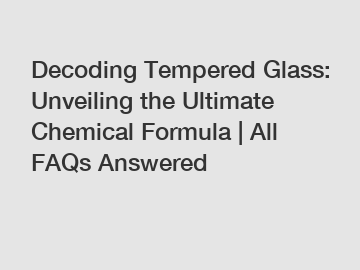Feb. 02, 2024
Construction
Decoding Tempered Glass: Unveiling the Ultimate Chemical Formula | All FAQs Answered?
What is the chemical formula of tempered glass? How is it made? How does it differ from other types of glass? These are just a few of the questions that frequently arise when discussing tempered glass. In this article, we will delve into the world of tempered glass, uncover its chemical formula, and answer all your FAQs about this unique material.
1. What is tempered glass?

Tempered glass is a type of safety glass that is strengthened through a heat treatment process known as tempering. This process involves heating the glass to a high temperature and then rapidly cooling it, creating internal compression. This compression enhances the mechanical strength and resilience of the glass, making it highly resistant to external forces and thermal stress. When broken, tempered glass shatters into small, pebble-like pieces rather than sharp shards, reducing the risk of injury.
2. Chemical composition of tempered glass.
The chemical formula for tempered glass is not unique to this type of glass alone, as it primarily consists of silica (SiO2), just like most other types of glass. However, the distinguishing characteristic of tempered glass lies in its internal structure. The rapid cooling during the tempering process creates a balance of internal stress, resulting in its unique mechanical properties.
3. How is tempered glass made?
To create tempered glass, the glass is first cut to the desired size and shape. It is then subjected to a series of preheating and heating stages. The preheating stage eliminates any residual moisture on the glass surface, while the heating stage raises the glass temperature to around 620°C (1150°F). Once the glass reaches the desired temperature, it is cooled rapidly using jets of air. This rapid cooling induces a state of high compression on the surface, while the interior remains in tension. This internal stress is what gives tempered glass its strength.
4. Advantages of tempered glass.
Tempered glass offers several advantages over regular glass. Its superior strength and resilience make it more resistant to external impact and thermal stress. This property makes it an ideal choice for applications where safety is paramount, such as in the automotive industry, construction, and manufacturing of electronic devices. Additionally, when tempered glass breaks, it disintegrates into small, blunt pieces, reducing the risk of injury.
5. Applications of tempered glass.
Tempered glass finds its use in various industries and applications. In the automotive sector, it is extensively used for side and rear windows, windshields, and sunroofs. Its strength and safety features make it highly suitable for buildings, where it is often used for windows, sliding doors, glass facades, and shower enclosures. Tempered glass is also found in household appliances, such as oven doors, refrigerator shelves, and stovetops.
6. How does tempered glass differ from other types of glass?
One significant difference between tempered glass and other types of glass is its strength. Tempered glass is about four times stronger than regular glass, making it more resistant to breakage due to impact or thermal stress. Another significant difference lies in its breakage pattern. Regular glass breaks into sharp, jagged shards that can cause severe injuries, while tempered glass shatters into small, pebble-like pieces. This property makes tempered glass safer for use in various applications.
7. Can tempered glass be cut or drilled?
Unlike regular glass, tempered glass cannot be cut or drilled after it has gone through the tempering process. Attempting to cut or drill tempered glass would cause it to shatter fully. Therefore, all shaping and hole-cutting processes must be done before the tempering process.
In conclusion, tempered glass is a high-strength and durable material that finds its application in diverse industries. Its chemical composition, primarily consisting of silica like most other glasses, is not unique. The distinctive characteristic of tempered glass lies in its internal stress, achieved through rapid cooling during the tempering process. This stress provides tempered glass with enhanced strength, making it resistant to external impact and thermal stress. With its safety features and widespread use, tempered glass continues to be a popular choice in various industries and applications.
For more tempered glasses of oem standards, tempered glass panels manufacturer, silk glassinformation, please contact us. We will provide professional answers.
Previous: Ultimate Wall Protection: Uncover the Best Hard Plastic Wall Protectors – The Ultimate Guide!
Next: Folding Container House for Sale: Modern, Eco-friendly & Cost-effective Housing Solution!
If you are interested in sending in a Guest Blogger Submission,welcome to write for us!
All Comments ( 0 )